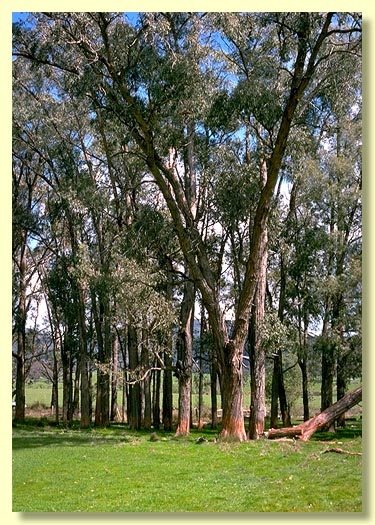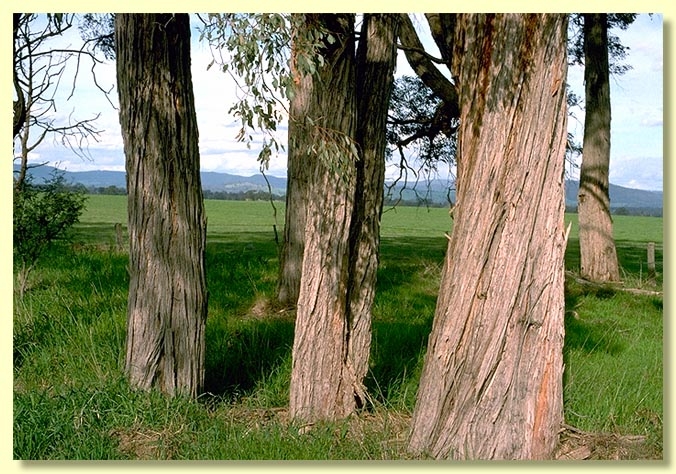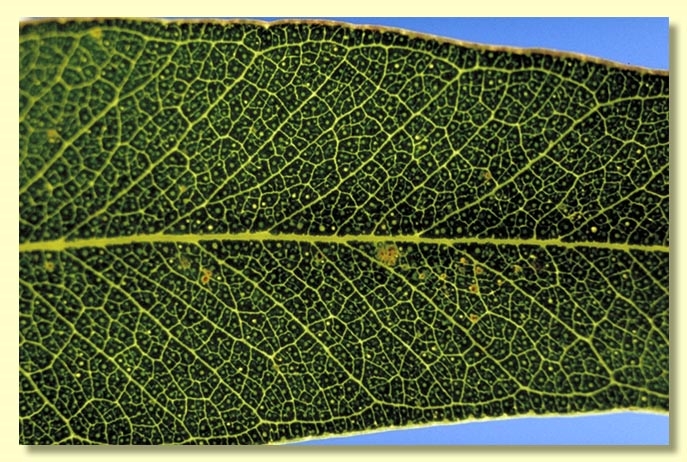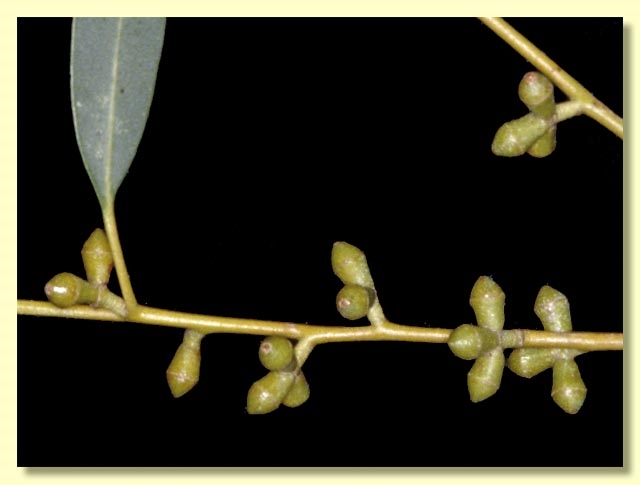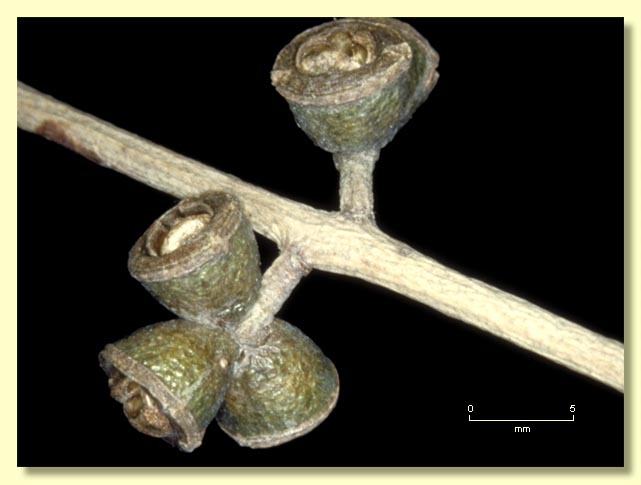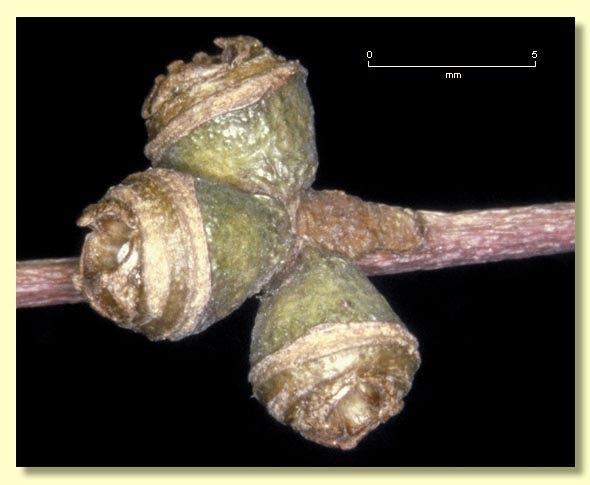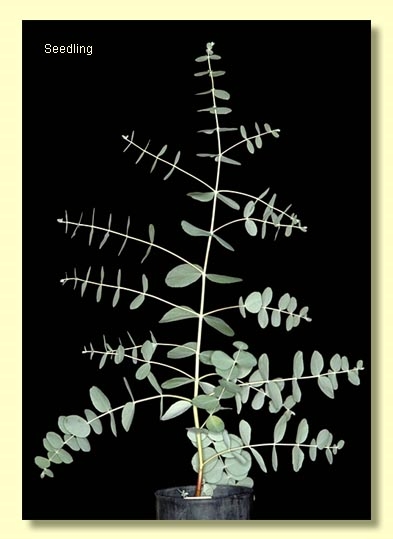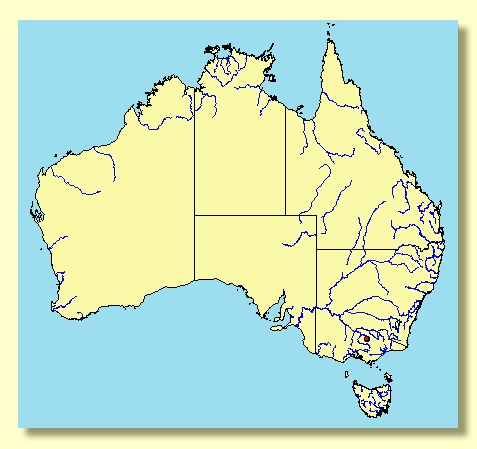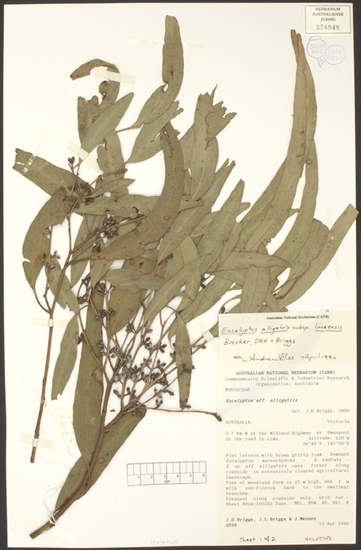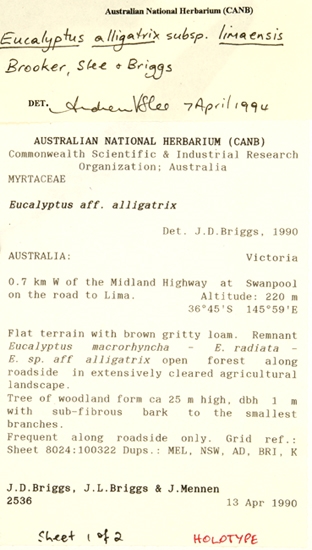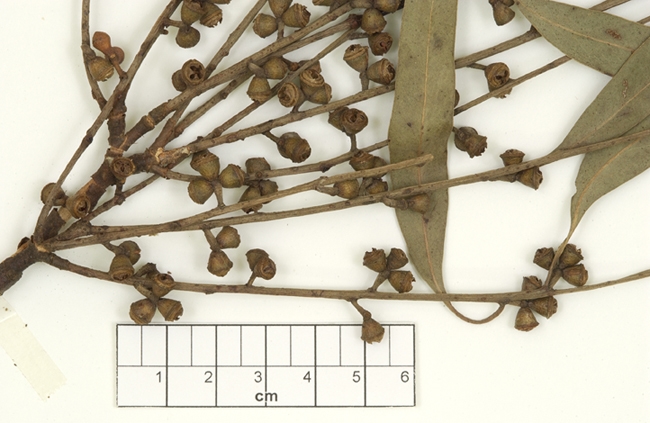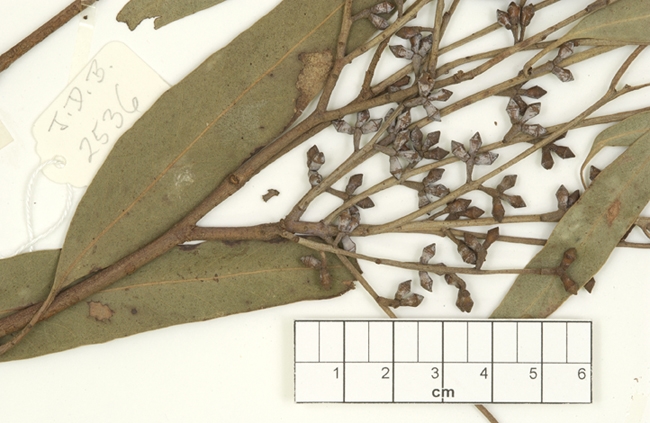Eucalyptus | Symphyomyrtus | Maidenaria | Euryotae | Argyrophyllae
Euclid - Online edition
Eucalyptus alligatrix subsp. limaensis
T: Victoria: 0.7 km W of Midland Highway at Swanpool on road to Lima, 13 Apr. 1990, J.D.Briggs 2536; holo: CANB; iso: AD, BRI, K, MEL, NSW.
Bark rough to small branches or rarely the branches <8cm diameter smooth, rough bark thick, fibrous, coarsely furrowed down trunk, dark grey; branchlets rarely glaucous.
Juvenile growth (coppice or field seedlings to 50 cm): stem rounded or square in cross-section, glaucous or non-glaucous, warty or smooth; juvenile leaves always opposite, sessile, orbicular or broadly ovate, 2–4.5 cm long, 2.5–5.2 cm wide, margin entire or crenulate, blue-green, grey-green or glaucous.
Crown composed entirely of narrowly lanceolate adult leaves.
Adult leaves alternate, petiole 0.8–2.5 cm long; blade narrowly lanceolate to falcate, 4.8–19.5 cm long, 0.7–1.8 cm wide, base tapering to petiole, margin entire, concolorous, glossy or dull, light green or grey-green, side-veins greater than 45° to midrib, moderately to densely reticulate, intramarginal vein parallel to and just within margin, oil glands numerous, mostly island.
Inflorescence axillary unbranched, peduncles 0.2–0.8 cm long, buds 3 per umbel, sessile or on pedicels only 0.1 cm long. Mature buds ovoid to diamond-shaped, 0.4–0.5 cm long, 0.2–0.3 cm wide, green or glaucous, sometimes slightly ridged, scar present, operculum conical, stamens inflexed, anthers cuboid or cuneate, versatile, dorsifixed, dehiscing by longitudinal slits (non-confluent), style long, locules 3 or 4, the placentae each with 4 vertical ovule rows. Flowers white.
Fruit sessile or on pedicels only 0.1 cm long, obconical or campanulate, 0.3–0.4 cm long, 0.4–0.5(0.7) cm wide, disc raised, valves 3 or 4, strongly exserted.
Seeds dark grey, brown or blackish, 1–1.6 mm long, ovoid or flattened-ovoid, often pointed at one end, usually lacunose, dorsal surface smooth or shallowly pitted, hilum ventral.
Cultivated seedlings (measured at ca node 10): cotyledons bilobed to oblong; stems rounded or square in cross-section, glaucous; leaves sessile and opposite for many nodes, orbicular to cordate, 2–3 cm long, 2–3.5 cm wide, base amplexicaul to rounded, apex emarginate, rounded or pointed, glaucous to grey-green.
Flowering time unknown.
Eucalyptus alligatrix is a small to medium-sized tree species of undulating to montane south-eastern Australia inland from the Great Dividing Range. It has extensive, thick rough fibrous bark, glaucous juvenile leaves and a crown of adult and intermediate leaves.
There are three subspecies differing in geography and proportion of adult and sub-adult leaves in the crown:
E. alligatrix subsp. alligatrix
From the Eildon – Jamieson – Big River area of Victoria with buds in threes and crown a mixture of alternate narrowly lanceolate adult and opposite, broadly lanceolate, intermediate leaves.
E. alligatrix subsp. limaensis
Occurs further north than subsp. alligatrix, only near Swanpool in Victoria. A taller tree with a completely adult crown of consistently alternate narrowly lanceolate leaves, buds in 3s and the smallest fruit of the three subspecies.
E. alligatrix subsp. miscella
Has a very restricted distribution near Rylstone, New South Wales, and is a smaller spreading woodland tree with a completely adult crown but with broader lanceolate leaves compared with subsp. limaensis. Bud clusters are a mixture of 3s and 7s on the same tree.
Eucalyptus alligatrix belongs in Eucalyptus subgenus Symphyomyrtus section Maidenaria, a large group of species more or less restricted to south-eastern Australia, characterised by bilobed cotyledons, simple axillary inflorescences, buds with two opercula, stamens with versatile anthers and flattened seeds with a ventral hilum. Within this section, E. alligatrix belongs in subsection Euryote series Argyrophyllae having longitudinally furrowed fibrous rough bark throughout, orbicular or ovate juvenile leaves opposite and sessile for many nodes, small diamond-shaped buds in 3s or mixed 3s and sevens and fruit with prominent disc and valves. E. alligatrix has a greener, more adult-leaved crown than E. cinerea and E. conspicua, whilst E. cephalocarpa and E. nova-anglica have buds in sevens. These 5 species form series Argyrophyllae.
Eucalyptus alligatrix subsp. limaensis and E. alligatrix subsp. miscella are both listed as "Vulnerable" under the Australian Government Environment Protection and Biodiversity Conservation Act 1999 (EPBC Act). Further information may be found at this web address:
http://www.environment.gov.au/cgi-bin/sprat/public/sprat.pl
subsp. limaensis: after the farming district, Lima, in north-east Victoria, where the subspecies occurrs.
subsp.miscella: Latin miscella, mixed, referring to the 3- and 7-flowered inflorescences on the same tree.

